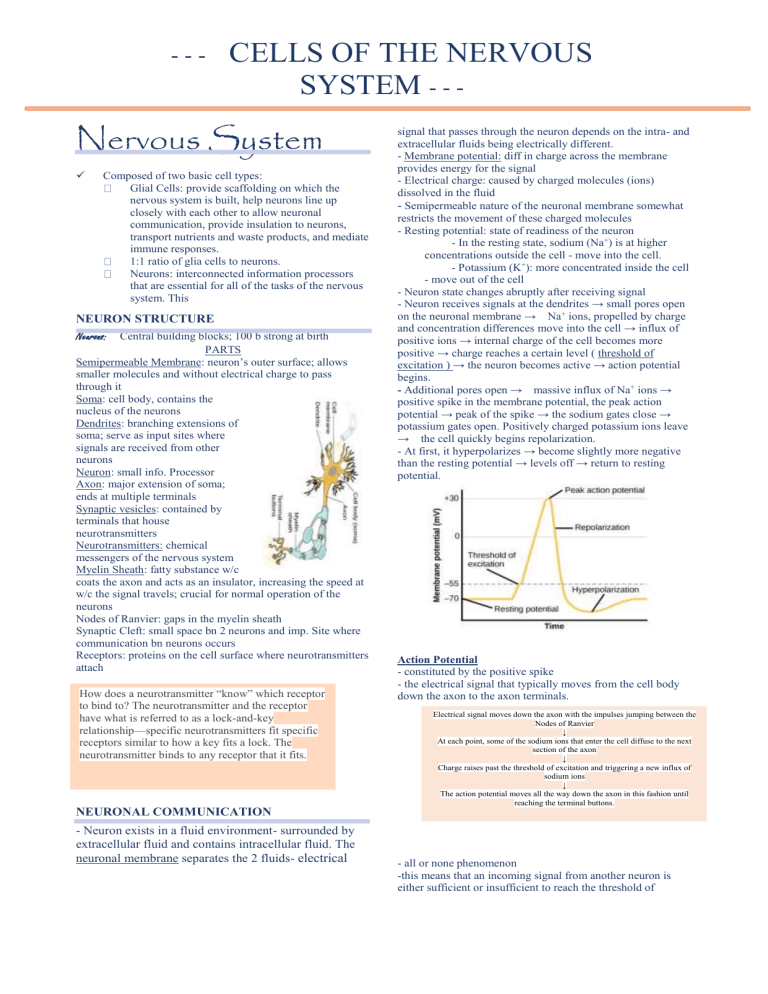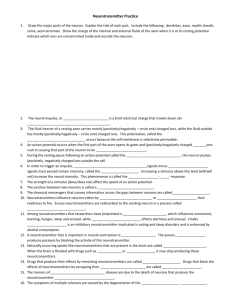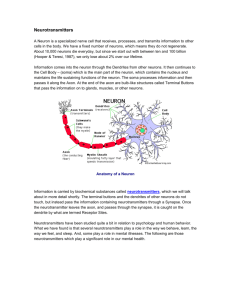Nervous System Cells: Neurons, Glia, Neurotransmitters
advertisement

--- CELLS OF THE NERVOUS SYSTEM - - - Nervous System Composed of two basic cell types: Glial Cells: provide scaffolding on which the nervous system is built, help neurons line up closely with each other to allow neuronal communication, provide insulation to neurons, transport nutrients and waste products, and mediate immune responses. 1:1 ratio of glia cells to neurons. Neurons: interconnected information processors that are essential for all of the tasks of the nervous system. This NEURON STRUCTURE Neurons: Central building blocks; 100 b strong at birth PARTS Semipermeable Membrane: neuron’s outer surface; allows smaller molecules and without electrical charge to pass through it Soma: cell body, contains the nucleus of the neurons Dendrites: branching extensions of soma; serve as input sites where signals are received from other neurons Neuron: small info. Processor Axon: major extension of soma; ends at multiple terminals Synaptic vesicles: contained by terminals that house neurotransmitters Neurotransmitters: chemical messengers of the nervous system Myelin Sheath: fatty substance w/c coats the axon and acts as an insulator, increasing the speed at w/c the signal travels; crucial for normal operation of the neurons Nodes of Ranvier: gaps in the myelin sheath Synaptic Cleft: small space bn 2 neurons and imp. Site where communication bn neurons occurs Receptors: proteins on the cell surface where neurotransmitters attach How does a neurotransmitter “know” which receptor to bind to? The neurotransmitter and the receptor have what is referred to as a lock-and-key relationship—specific neurotransmitters fit specific receptors similar to how a key fits a lock. The neurotransmitter binds to any receptor that it fits. signal that passes through the neuron depends on the intra- and extracellular fluids being electrically different. - Membrane potential: diff in charge across the membrane provides energy for the signal - Electrical charge: caused by charged molecules (ions) dissolved in the fluid - Semipermeable nature of the neuronal membrane somewhat restricts the movement of these charged molecules - Resting potential: state of readiness of the neuron - In the resting state, sodium (Na+) is at higher concentrations outside the cell - move into the cell. - Potassium (K+): more concentrated inside the cell - move out of the cell - Neuron state changes abruptly after receiving signal - Neuron receives signals at the dendrites → small pores open on the neuronal membrane → Na+ ions, propelled by charge and concentration differences move into the cell → influx of positive ions → internal charge of the cell becomes more positive → charge reaches a certain level ( threshold of excitation ) → the neuron becomes active → action potential begins. - Additional pores open → massive influx of Na+ ions → positive spike in the membrane potential, the peak action potential → peak of the spike → the sodium gates close → potassium gates open. Positively charged potassium ions leave → the cell quickly begins repolarization. - At first, it hyperpolarizes → become slightly more negative than the resting potential → levels off → return to resting potential. Action Potential - constituted by the positive spike - the electrical signal that typically moves from the cell body down the axon to the axon terminals. Electrical signal moves down the axon with the impulses jumping between the Nodes of Ranvier ↓ At each point, some of the sodium ions that enter the cell diffuse to the next section of the axon ↓ Charge raises past the threshold of excitation and triggering a new influx of sodium ions ↓ The action potential moves all the way down the axon in this fashion until reaching the terminal buttons. NEURONAL COMMUNICATION - Neuron exists in a fluid environment- surrounded by extracellular fluid and contains intracellular fluid. The neuronal membrane separates the 2 fluids- electrical - all or none phenomenon -this means that an incoming signal from another neuron is either sufficient or insufficient to reach the threshold of excitation. There is no in-between, and there is no turning off an action potential once it starts. - the action potential is recreated, or propagated, at its full strength at every point along the axon. - Explains the fact that your brain perceives an injury to a distant body part like your toe as equally painful as one to your nose - Action potential arrives at terminal→ synaptic vesicles release neurotransmitters → neurotrans travels across synapse → binds to receptors on dendrites → process repeats in the neuron → signal delivered → excess neurotrans in synaptic cleft drift away → broken into inactive fragments → or reabsorbed in reuptake process - Reuptake: neurotransmitter being pumped back into the neuron that released it to clear the synapse -Clearing the synapse serves both to provide a clear “on” and “off” state between signals and to regulate the production of neurotransmitter Neuronal communication is often referred to as an electrochemical event. The movement of the action potential down the length of the axon is an electrical event, and movement of the neurotransmitter across the synaptic space represents the chemical portion of the process. NEUROTRANSMITTERS AND DRUGS - diff. types of neurotransmitters are released by diff. Neurons - biological perspective: focus on physiological causes of behavior - Psychotropic medications: drugs that treat psychiatric symptoms by restoring neurotransmitter balance Major Neurtransmitters And How they Affect Behavior Neurotransmitter Involved in Potential Effect on Behavior Acetylcholine Muscle action, Increased arousal, memory enhanced cognition Beta-endorphine Pain, pleasure Decreased anxiety and tension Dopamine Mood, sleep, Increased pleasure, learning suppressed appetite Gamma-aminobutyric Brain function, sleep Decreased anxiety acid (GABA) and tension Glutamate Memory, learning Increased learning, enhanced memory Norepinephrine Heart, intestines, Increased arousal, alertness suppressed appetite Serotonin Mood, sleep Modulated mood, suppressed appetite Psychoactive drugs: acts as antagonists or agonists for a given neurotransmitter : represent drugs that are prescribed to correct imbalance Agonists - chemical that mimic a neurotransmitter at the recepor site Antagonists - blocks or impedes the normal activity of a neurotransmitter at the receptor Example: PARKINSON’S DISEASE - progressive nervous system disorder - low levels of dopamine - common treatment strategy: increase dopamine agonists SCHIZOPHRENIA - overactive dopamine - antagonists for dopamine Reuptake Inhibitors: prevent unused neurotransmitters from being transported back to the neuron; allows neurotransmitters to remain active in the synaptic cleft for longer durations = increased effectiveness Example: DEPRESSION - reduced serotonin levels - commonly treated w/ selective serotonin reuptake inhibitors (SSRIs).



